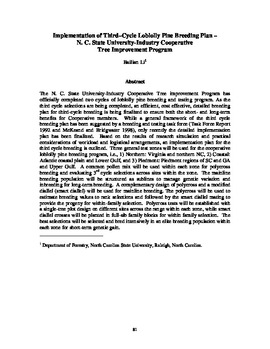| dc.contributor.author | Li, B. | |
| dc.date.accessioned | 2016-04-25T19:35:58Z | |
| dc.date.available | 2016-04-25T19:35:58Z | |
| dc.date.issued | 2003 | |
| dc.identifier | oksd_sf27_p081.pdf | |
| dc.identifier.citation | Li, B. (2003). "Implementation of Third-Cycle Loblolly Pine Breeding Plan - N. C. State University-Industry Cooperative Tree Improvement Program." In 27th Southern Forest Tree Improvement Conference, Stillwater, OK | |
| dc.identifier.uri | https://hdl.handle.net/11244/33668 | |
| dc.description.abstract | The N. C. State University-Industry Cooperative Tree improvement Program has officially completed two cycles of loblolly pine breeding and testing program. As the third cycle selections are being completed, an efficient, cost effective, detailed breeding plan for third-cycle breeding is being finalized to ensure both the short- and long-term benefits for Cooperative members. While a general framework of the third cycle breeding plan has been suggested by a breeding and testing task force (Task Force Report 1992 and McKeand and Bridgwater 1998), only recently the detailed implementation plan has been finalized. Based on the results of research simulation and practical considerations of workload and logistical arrangements, an implementation plan for the third cycle breeding is outlined. Three general test zones will be used for the cooperative loblolly pine breeding program, i.e., 1) Northern: Virginia and northern NC, 2) Coastal: Atlantic coastal plain and Lower Gulf, and 3) Piedmont: Piedmont regions of SC and GA and Upper Gulf. A common pollen mix will be used within each zone for polycross breeding and evaluating 3rd cycle selections across sites within the zone. The mainline breeding population will be structured as sublines to manage genetic variation and inbreeding for long-term breeding. A complementary design of polycross and a modified diallel (smart diallel) will be used for mainline breeding. The polycross will be used to estimate breeding values to rank selections and followed by the smart diallel mating to provide the progeny for within-family selection. Polycross tests will be established with a single-tree plot design on different sites across the range within each zone, while smart diallel crosses will be planted in full-sib family blocks for within family selection. The best selections will be selected and bred intensively in an elite breeding population within each zone for short-term genetic gain. | |
| dc.format | application/pdf | |
| dc.language | en_US | |
| dc.relation.ispartofseries | Sponsored publication . . . of the Southern Forest Tree Improvement Committee ; no. 49 | |
| dc.rights | This paper is made available through open access and the auspices of the fair use doctrine for scholarly, educational and research purposes while recognizing the publisher already offers a free online version. The OSU Library�s intent is to offer access and preserve publications involving its faculty contributions. Contact the Digital Resources and Discovery Services at lib-dls@okstate.edu or 405-744-9161 for the permission policy on the use, reproduction or distribution of this material. | |
| dc.source | Proceedings of the 27th Southern Forest Tree Improvement Conference, volume 27, 2003. Editor, Craig R. McKinley. | |
| dc.title | Implementation of Third-Cycle Loblolly Pine Breeding Plan - N. C. State University-Industry Cooperative Tree Improvement Program | |
| dc.type | text | |
| osu.filename | oksd_sf27_p081.pdf | |
| dc.type.genre | Conference proceedings | |
| dc.description.scopeandcontents | Papers and abstracts from the 27th Southern Forest Tree Improvement Conference held at Oklahoma State University in Stillwater, Oklahoma on June 24-27, 2003. | |
